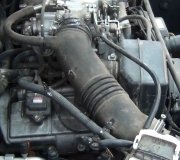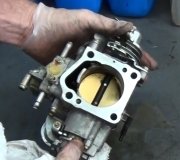I thank you for that response, and it does seem to address something of the matter I raised.
.
As an aside, the air filter on the Scout II diesels is on the left side of the engine (driver's perspective) above the intake/exhaust manifolds, and connects directly to the turbo.
.
The radiator, which is larger than for the standard in-line 6, or slant 4 (both gasoline), is right in front of and just below the air horn "” about 8 inches away.
.
So any air must arrive from that source, or from below that point (the roadway).
.
My question however was why the air horn has such as small inside diameter such as to actually restrict the volume (quantity) of air.
.
Mind you, that small opening doesn't in any way seem to affect the operation of the engine that I am able to determine. In all the years I've owned the vehicle (since new) I never detected an air starvation problem, at least that I was able to discern.
.
Now I will suppose that upon further cogitation here, someone might ask: Well, if the intake valve opening isn't much larger, then why even ask?
.
But of course that would neglect to consider that the total train of air isn't dependent upon just one intake valve, and in fact must consider all six operating at high speed.
.
I wish I could pick the mind of one of the Nissan engineers who knows about that engine!
.
I'm just curious as to what the possible effect might be with a larger opening, or if I should even attempt such. I wouldn't think that it would matter, inasmuch that the exit opening of the air filter (going to the turbo) is almost =3 times= the size of the ID of air horn!
.
But again: I thank you for taking the time to reply!
Saturday, April 25th, 2009 AT 10:46 AM



